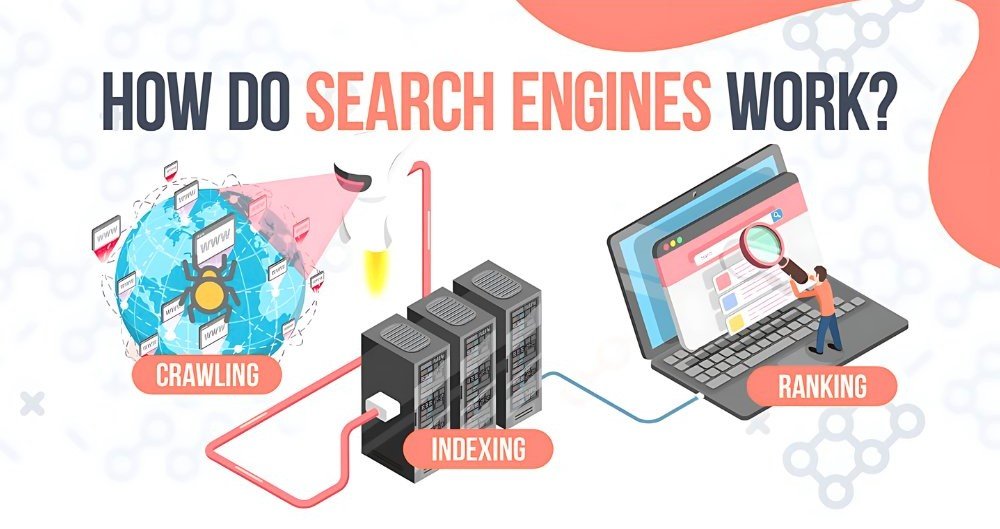
Finding what you need online happens so quickly, it feels automatic.
Behind those few seconds, though, search engines are running an incredibly detailed process. Learning how search engines work can change the way you approach your own website, and give you a better shot at getting found when it matters most.
Here’s a simple breakdown of what happens behind the scenes.
What is a search engine?
At its core, a search engine is a software system built to find, organize, and deliver information from the internet.
Google is the best-known example, handling billions of searches every day, but it’s not the only one. Bing, Yahoo, and DuckDuckGo all operate with the same core goal: get users the information they’re looking for, fast.
Every search engine follows the same basic three steps:
-
Crawling: Discovering content on the internet
-
Indexing: Organizing and storing that content
-
Ranking: Sorting the results based on relevance and quality
Let’s walk through how each part works.

Crawling: How search engines find content
Crawling is the search engine’s way of exploring the internet.
Specialized programs called crawlers or spiders hop from link to link, grabbing new and updated pages as they go. Learning how search engines crawl websites gives you insight into how your pages get discovered.
Here’s the basic flow:
- Starting out: Crawlers start with a known list of URLs.
- Following links: They move through hyperlinks to discover new pages.
- Fetching content: The HTML of each page is downloaded.
- Sending it back: The information is returned to the search engine for analysis.
Challenges crawlers face
-
Dynamic pages: Some pages generate content on the fly, which can make them harder to reach.
-
Crawl budget: Every site has a limit to how often and deeply it’s crawled.
-
Blocking rules: Some pages are off-limits, set by website owners through robots.txt files or meta tags.
Without crawling, your website could be invisible to search engines, no matter how good your content is.
Understanding how search engines handle crawling vs indexing is key to making sure your important pages get found and stored correctly.
Indexing: Storing and organizing the web
Once pages are crawled, search engines have to store the information in a way that makes it easy to retrieve later. That’s what indexing is all about.
During indexing, search engines:
-
Analyze each page’s content, looking at text, images, and metadata.
-
Break it down into an organized entry with keywords, topics, and relationships to other pages.
-
Store everything in a massive database called the search index.
If your page isn’t indexed, it won’t show up in search results, no matter how well it’s optimized.
A strong, clean index allows a search engine to deliver faster, better results for users. Knowing how search engines index content can help you structure your pages for better visibility.
Ranking: How results are ordered
When you search for something, the engine doesn’t comb the entire web in real time. Instead, it searches its index, then ranks the most relevant results based on a long list of signals.
What matters for ranking?
-
Relevance: How well your page matches the searcher’s intent.
-
Quality: Trustworthiness, authority, and user experience all weigh heavily.
Key ranking signals:
-
Keywords: Where and how keywords appear naturally in the content.
-
Backlinks: External sites linking to your page signal authority.
-
User engagement: Metrics like click-through rate and time spent on page show user satisfaction.
-
Mobile-friendliness: A seamless mobile experience is a must.
Search engines constantly balance these factors to make sure users get the most helpful results, not just the ones stuffed with keywords.
Understanding search engine ranking factors and how they continue to evolve can make the difference between showing up on the first page of SERPs or getting buried in the noise.
How search engine algorithms shape results
Behind all of this is a complex system of algorithms. These are sets of rules and calculations that help the search engine decide which results to show, and in what order.
Today’s algorithms are much more sophisticated than they were even a few years ago.
They look at hundreds (sometimes thousands) of factors, with a heavy emphasis on:
- Relevance: Matching the search query with relevant content.
- Freshness: Giving priority to newer content.
- Authority: Evaluating the credibility of the content and its sources.
- User Signals: Analyzing user behavior to refine rankings.
If you want your site to perform well, it’s crucial to understand how Google search algorithms work and stay in-the-know on major algorithm updates (like Google’s Helpful Content update or Core Updates), which can cause noticeable shifts in rankings.
Website owners often need to adjust strategies when these changes roll out.
Why user intent matters more than ever
A search engine’s main job is to understand why someone is searching.
That’s called user intent.
Different types of user intent include:
-
Informational: Trying to learn something (e.g., “how to fix a leaky faucet”)
-
Navigational: Looking for a specific site or brand (e.g., “Nike official store”)
-
Transactional: Ready to make a purchase or complete an action (e.g., “buy running shoes online”)
Good SEO aligns your content with user intent.
When your pages deliver exactly what someone is looking for, rankings tend to follow.
Tips for optimizing for user intent
-
Create content that clearly answers specific questions or solves problems.
-
Make navigation intuitive so users can find what they need quickly.
-
Focus on helpfulness over keyword stuffing.
Pages that match what affects SEO rankings, like relevance and intent, tend to outperform those that only focus on keywords.
Core factors that impact search engine rankings
Some elements of SEO carry more weight than others. Focusing on these key areas will put you in a stronger position:
-
Content Quality: Unique, helpful, well-structured writing that serves a purpose.
-
Backlinks: Links from credible, relevant websites.
-
User Experience (UX): Fast-loading pages, mobile optimization, and easy navigation.
-
Technical SEO: Proper use of title tags, meta descriptions, clean URLs, and structured data.
-
Social signals: Shares, likes, and overall engagement can be small but helpful trust indicators.
No one factor works in isolation. It’s the combination that matters.
How to optimize your website for search engines
Understanding how search engines work is the first step in optimizing your website for better visibility and higher rankings.
By focusing on crawling, indexing, ranking, and the factors that influence these processes, you can develop a comprehensive SEO strategy that drives organic traffic and achieves your business goals.
Now that you know how search engines operate, here’s where you can start improving your own site:
On-Page SEO
-
Keyword placement: Use natural language; don’t force it.
-
Meta tags: Write clear, engaging titles and descriptions.
-
Internal linking: Help users (and crawlers) easily move through your site.
-
Content quality: Focus on solving problems, not just ranking for terms.
If you’re just starting out, following these simple SEO tips for beginners can dramatically improve your visibility without feeling overwhelming.
Technical SEO
-
Speed matters: Optimize images, minimize scripts, and use caching.
-
Mobile first: Your site should look and perform great on phones.
-
Crawlability: Check your robots.txt and use a clean site structure.
-
Structured data: Add schema markup where it makes sense (like for blog posts, products, reviews).
Off-Page SEO
-
Build high-quality links: Focus on getting backlinks from reputable sites in your industry.
-
Leverage social media: Share your content where your audience is active.
-
Local SEO: If you serve a specific area, optimize your Google Business Profile and local citations.
Final Thoughts
Understanding how search engines work gives you a major advantage.
You’re no longer guessing what’s happening behind the scenes.
You’re building smarter, faster, and with a purpose.
Good SEO isn’t about chasing algorithms. It’s about delivering real value, making your site easy to navigate, and helping search engines (and users) trust what you have to offer.
Stay consistent, keep learning, and your organic traffic will grow.
Let’s grow your traffic together
Have an SEO question or need help with a project? Whether you’re a small business or a national brand, I’ll help you rank higher and convert more.
